 THE MINERAL HEMATITE
THE MINERAL HEMATITE
Like:
Share:
- Chemical Formula: Fe2O3, Iron Oxide
- Class: Oxides and Hydroxides
- Group: Hematite
- Uses: Very important ore of iron, as a pigment and as mineral specimens.
Specimens
- Hematite Rose is a circular arrangement of bladed crystals giving the appearance of the flower of a rose.
- Tiger Iron is a sedimentary deposit of approximately 2.2 billion years old that consists of alternating layers of silver gray hematite and red jasper, chert or even tiger eye quartz.
- Kidney Ore is the massive botryoidal form and gives the appearance of lumpy kidney-like masses.
- Oolitic Hematite is a sedimentary formation that has a reddish brown color and an earthy luster and is composed of small rounded grains.
- Specularite is a micaceous or flaky stone that is sparkling silver gray and sometimes used as an ornamental stone.
Hematite is sometimes used in jewelry, either as black reflective stones or as a jewelry piece itself (such as a ring). Some jewelry is marketed as "magnetic hematite". I believe that is more likely another iron oxide, magnetite.
The "not really a true mineral" known as Limonite is a mixture of hematite, Goethite, and possibly other similar hydrated oxides and hydroxides. Hematite is a primary component of ordinary rust, but the porousity, softness, and flakyness of rust is likely due to goethite.
The beautiful iridescent coating sometimes found on hematite is due to Turgite, still another "not really a" mineral composed of a mixture of hematite and goethite and sometimes described as being a hydrated hematite.
PHYSICAL CHARACTERISTICS:
- Color is steel or silver gray to black in some forms and red to brown in earthy forms. Sometimes tarnished with iridescent colors when in a hydrated form (called Turgite).
- Luster is metallic or dull in earthy and oolitic forms.
- Transparency: Crystals are opaque.
- Crystal System is trigonal; bar 3 2/m
- Crystal Habits include tabular crystals of varying thickness sometimes twinned, micaceous (specular), botryoidal and massive. also earthy or oolitic.
- Cleavage is absent. However, there is a parting on two planes.
- Fracture is uneven.
- Hardness is 5 - 6
- Specific Gravity is 5.3 (slightly above average for metallic minerals)
- Streak is blood red to brownish red for earthy forms.
- Associated Minerals include jasper (a variety of quartz) in banded iron formations (BIF or Tiger Iron), dipyramidal quartz, rutile, and pyrite among others.
- Notable Occurrences especially nice specimens come from England, Mexico, Brazil, Australia and the Lake Superior region.
- Best Field Indicators are crystal habit, streak and hardness.
 Amethyst Galleries' Mineral Gallery MINERALS |
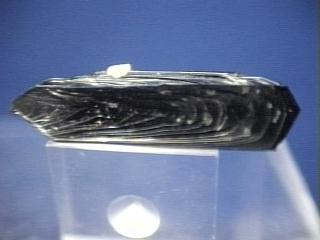
HEMATITE specimen hem-1
$ 15.00
$ 15.00
Dims: 1-3/4"x1/2"x 3/16"
Wt: 0.1 oz
Nador, Morocco
Do you know how common Hematite is? It's SO common that we must have a pretty spectacular specimen to put on this net shop! This thing is WEIRD! I don't even know why I should call it a crystal, but that's what it is. First, it's hollow; it looks like it was a coating for a long, prismatic crystal that moldered away. Looking down along its length one can see it's rhombohedrally shaped, and looking at its sides, a hopper-crystal effect is clearly noticeable.

hem-1 ($ 15.00)
Nador, Morocco
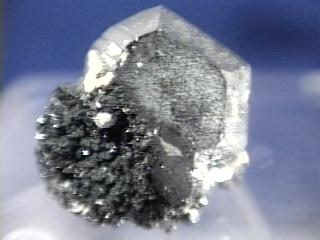
HEMATITE specimen hem-2
$ 90.00
$ 90.00
Dims: 1"x1"x 1-1/2"
Wt: 1.2 oz
Wessel Mine, Kuruman, South Africa
We consider this to be the best single hematite crystal that we've ever seen, barring its lack of completeness. Its thick, hexagonal tabular shape is very clean and well-defined, with the classic Hematite dark-metallic luster. If you're looking for an exceptional crystalline example of Hematite, this piece is a viable option!

hem-2 ($ 90.00)
Wessel Mine, Kuruman, South Africa
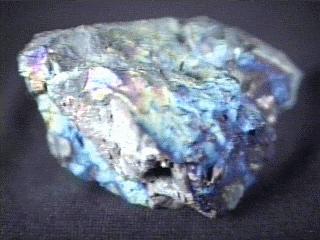
HEMATITE specimen hem-8
$ 54.00
$ 54.00
Dims: 3-5/8" x 2-7/8" x 1-3/4"
Wt: 12.9 oz
Goldfield District, Nevada, U.S.A.
I would say that this Turgite specimen "has some heft"- it weighs in at over 3/4 lb. Where there is no iridescence, the black material has a dull luster, with some areas appearing to have spots of "rust" on them. The iridescent areas have colors that span the visible spectrum and a submetallic to a metallic(occasionally!) luster. There is no visible matrix, but one area has a white, powdery substance on it that seems to have occurred with the other material. I love the iridescent color- it reminds me of the rainbows that oil leaves on water.

hem-8 ($ 54.00)
Goldfield District, Nevada, U.S.A.
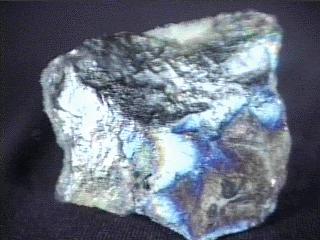
HEMATITE specimen hem-9
$ 54.00
$ 54.00
Dims: 3-5/8" x 2-7/8" x 1-3/4"
Wt: 7.1 oz
Goldfield District, Nevada, U.S.A.
One of the more colorful Turgite specimens that I have seen, this pleasant chunk of hydrated iron oxide not only has a generous rainbow-colored iridescent coating, it also shows a surprisingly large amount of botryoidal formation. These formations do not get very big(mostly 1/16" diameter nodules or smaller), but they cover an impressive percentage of the specimen's surface area. The piece's color spans the visible spectrum, and most of the iridescing areas have a submetallic to metallic luster. The areas without color also have a generous amount of this luster, which helps to emphasize the points where the iridescence begins. There is a whitish to colorless material that coats a part of the surface that I cannot identify that seems to be a bit weathered, but has a vitreous luster and no definite crystal form. Hmmm. Pretty rock, though.
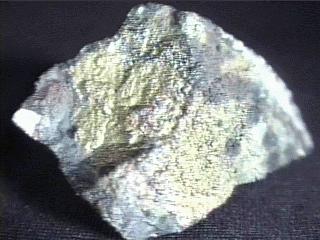

hem-9 ($ 54.00)
Goldfield District, Nevada, U.S.A.
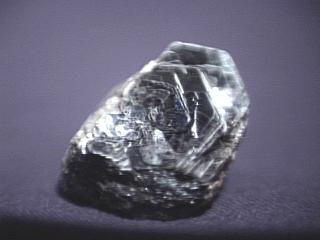
HEMATITE specimen hem-12
$ 38.00
$ 38.00
Dims: 1.6" x 1.3" x 1.0"(4.1 x 3.3 x 2.5 cm)
Wt: 2.36 oz.(66.9 g)
Ouro Preto, Minas Gerais, Brazil
This Hematite specimen occurs in the form of dozens of hexagonal platelets that are stacked together in a curving arc- the formation is called an iron rose. The platelets have excellent hexagonal shape and are damaged only at one end of the stack. They have the standard dark gray color, metallic luster, and opacity of Hematite on their basal faces, and their edges are a metallic red color. Two opposing sides of these edges are covered with clusters of tiny muscovite platelets. It is lovely to look upon!
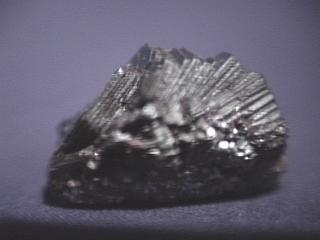

hem-12 ($ 38.00)
Ouro Preto, Minas Gerais, Brazil
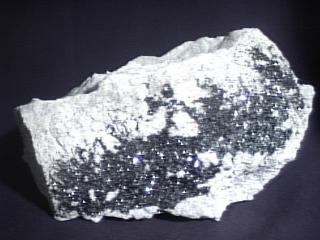
HEMATITE specimen hem-14
$ 70.00
$ 70.00
Dims: 8.7" x 5.0" x 3.3" (22.1 x 12.7 x 8.4 cm)
Wt: 4 lbs., 7.4 oz. (2.024 kg)
Nador, Morocco
Hundreds of tiny Hematite platelets are liberally sprinkled on one face of the host rock of this specimen. They occur in the form of misshapen tabular platelets that do not exceed 3 mm in diameter or 1 mm in thickness. As the platelets are so small and misshapen, it is difficult to determine the presence or extent of any damage to them; they do, however, have clean faces with no visible striations, so they sparkle rather brightly. The crystals have the standard dark gray color and metallic luster of Hematite. The larger crystals (those that exceed 1 mm in diameter) are concentrated into a thin encrustation on one face of the host, but hundreds more submicroscopic crystals are scattered elsewhere on the specimen. Examination of these crystals under magnification shows that many of them have very good hexagonal form. The host rock resembles some rhyolites that I have seen, but seems to be a bit soft- it may be a variety of shale.
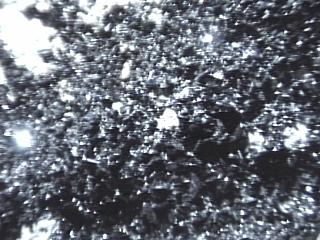

hem-14 ($ 70.00)
Nador, Morocco
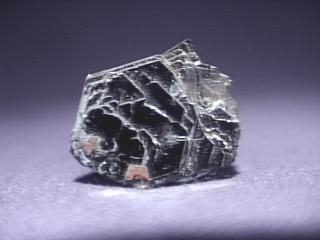
HEMATITE specimen hem-17
$ 26.00
$ 26.00
Dims: 1.2" x 0.9" x 0.4" (3.0 x 2.3 x 1.0 cm)
Wt: 16.4 g
Ouro Preto, Minas Gerais, Brazil
This thumbnail specimen consists of a cluster of stacked hexagonal tabular crystals. I hesitate to call it an "iron rose", as the formation just doesn't bring that to mind. Some of the platelets are damaged and incomplete, but most are intact and show excellent form and a good hexaonal outline. They have the standard dark-gray coloration and a dull metallic luster along their edges, whereas their faces show a much brighter metallic shine. It is a pretty piece that I might just have to purchase for myself if nobody else does.
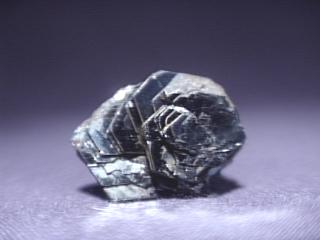

hem-17 ($ 26.00)
Ouro Preto, Minas Gerais, Brazil
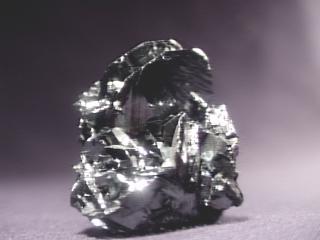
HEMATITE specimen hem-18
$ 150.00
$ 150.00
Dims: 2.3" x 1.9" x 1.6" (5.8 x 4.8 x 4.1 cm)
Wt: 5.58 oz. (158.5 g)
Punta Calamita, Elba Island, Italy
Though most of the visible crystals on this specimen show damage in one form or another, it is still a rather impressive specimen, for two reasons: its locality, and the two largest crystals on it. These two crystals grow parallel and adjacent to each other, and appear to be tangent to each other near their bases. They both measure approximately 1" (2.5 cm) in diameter and 0.2" (5 mm) in thickness. Though they are damaged, their crystal form is quite evident. However, I cannot classify it, though it must be hexagonal-based. The crystals generally are much thicker than most Hematite tablets that I have seen, and each blade shows subtle but definite curvature on certain faces. Even the largest faces are made up of smaller faces that make them appear curved. They have the standard dark gray color and metallic luster that one expects from Hematite, and show patches of iridescence on some smaller faces. There are a few small hexagonal prismatic quartz crystals among the smaller Hematite blades- these are transparent and seemingly clear, but appear almost white due to their matte luster. There is no other material, and more massive Hematite seems to act as a host rock. I find it intriguing to consider that Napoleon may have walked on the earth over this specimen during his exile!
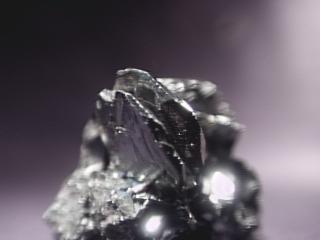

hem-18 ($150.00)
Punta Calamita, Elba Island, Italy
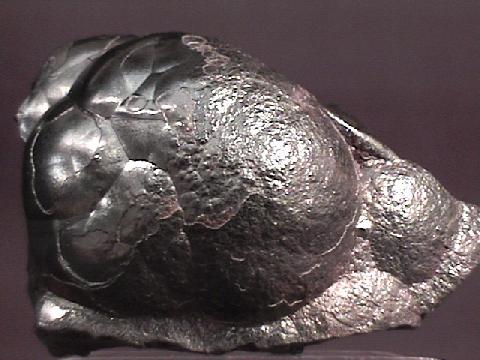
HEMATITE specimen hem-19
$ 40.00
$ 40.00
Dims: 2.3" x 1.5" x 1.3" (5.8 x 3.8 x 3.3 cm)
Wt: 4.91 oz. (139.4 g)
Minas Gerais, Brazil
This small hand specimen consists of a portion of a botryoidal crust of Hematite that is often called kidney stone. It has a few interesting aspects to it. Most of its outer surface has a rather rough, pebbly texture that dulls its metallic luster. Only a small portion of this surface has a very smooth texture that enables one to see its metallic luster at its brightest. Examination of the crust's cross-section shows a distinctly radial pattern that suggests that the material had an almost fibrous habit at some point. Examination of its botryoidal surface, however, shows patterns that suggest concentric layering. After thinking about it, it would seem that the material DID form in a nearly acicular fashion, but was then partially covered over with smoother layers of Hematite. Examination of the specimen's underside shows a distinct lack of any host rock or material and the distinct red coloration of decayed Hematite.
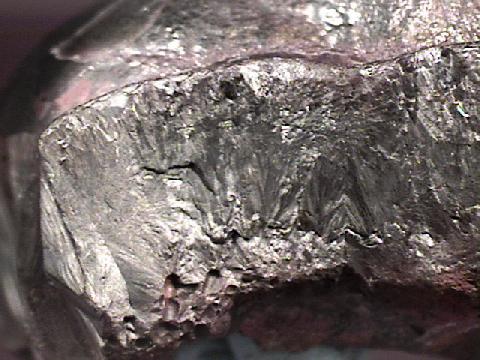

hem-19 ($ 40.00)
Minas Gerais, Brazil
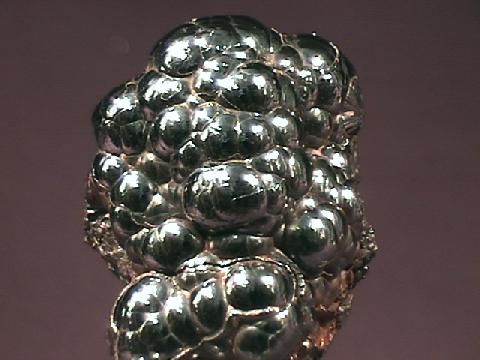
HEMATITE specimen hem-20
$ 27.00
$ 27.00
Dims: 1.9" x 1.6" x 1.6" (4.8 x 4.1 x 4.1 cm)
Wt: 5.11 oz. (145.2 g)
Chihuahua, Mexico
This specimen is another example of the form of Hematite that is known as kidney stone. It consists of many intergrown nodules of Hematite that appear to have been polished to show better relief and detail. The nodules have the standard dark gray color and metallic luster of Hematite, and show hints of dull reddish color in the crevices where the nodules meet. A cross-section of the nodules shows their compact, radiating tendencies (see the close-up image). The entire specimen consists of Hematite, most of which is in a botryoidal form- there is no host rock of any kind present.
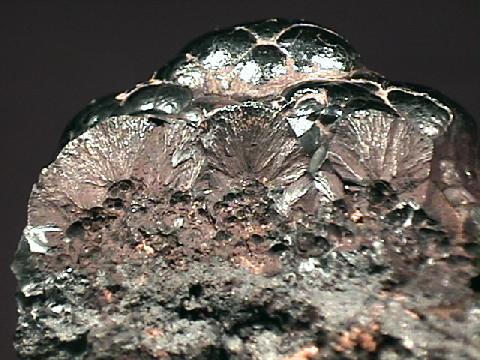

hem-20 ($ 27.00)
Chihuahua, Mexico
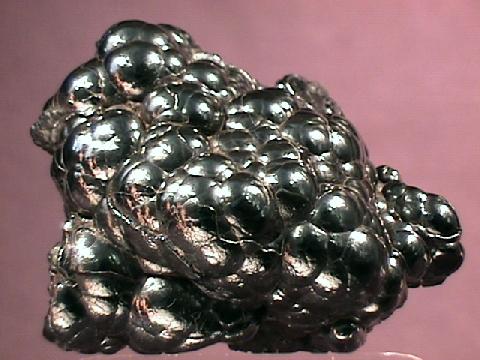
HEMATITE specimen hem-21
$ 30.00
$ 30.00
Dims: 2.4" x 2.1" x 1.4" (6.1 x 5.4 x 3.6 cm)
Wt: 5.98 oz. (169.4 g)
Chihuahua, Mexico
This specimen consists entirely of part of a botryoidal crust of Hematite nodules of the variety sometimes called kidney ore. These nodules are heavily intergrown, so determining their mean size is difficult. However, they have excellent form and have been polished to accentuate their detail. All have a dark gray coloration and a dull metallic luster. Areas of their cross-section show a densely compact and finely fibrous, radiating pattern (see the close-up image). The underside of the specimen shows an irregular, amorphous surface that is slightly coated with a thin layer of rust.
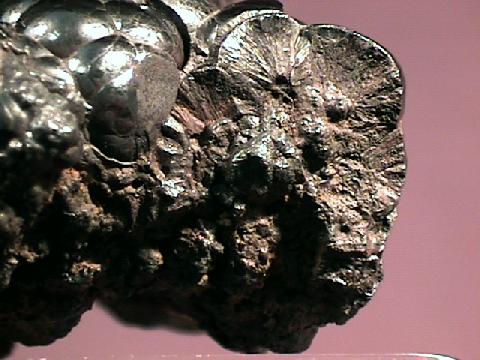

hem-21 ($ 30.00)
Chihuahua, Mexico
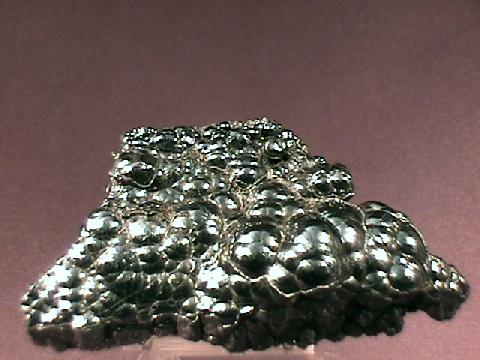
HEMATITE specimen hem-22
$ 65.00
$ 65.00
Dims: 4.1" x 2.5" x 1.1" (10.4 x 6.4 x 2.8 cm)
Wt: 9.51 oz. (269.7 g)
Chihuahua, Mexico
A botryoidal crust of "kidney ore" Hematite constitutes this Mexican specimen. The thickness of the crust varies considerably, ranging from 0.2 - 0.6" (0.5 - 1.5 cm) and is composed of intergrown Hematite nodules that have been polished to show off their dark gray color and dull metallic luster. The cross-sections of these nodules show compact, fibrous, and radiating tendencies (see the close-up image), and the surface of their underside shows some warped botryoidal and almost crystalline form.. There is a small amount of a dull, brownish rock attached to the underside which may have been stained by the rust that stains the rest of this surface.
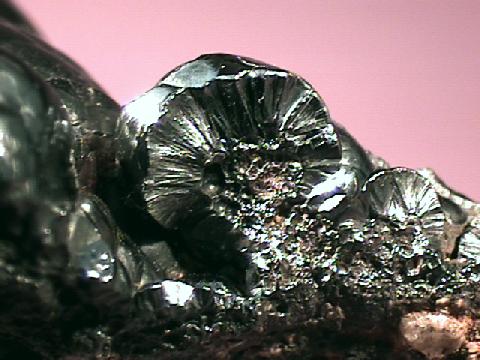

hem-22 ($ 65.00)
Chihuahua, Mexico
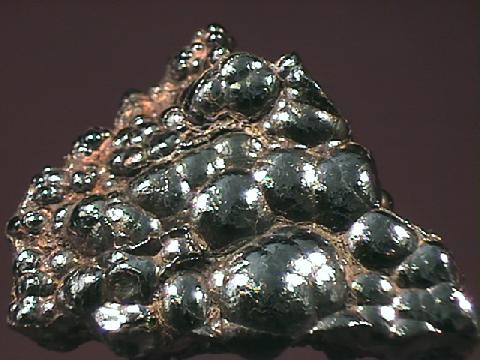
HEMATITE specimen hem-23
$ 25.00
$ 25.00
Dims: 1.9 x 1.4 x 0.6" (4.8 x 3.6 x 1.5 cm)
Wt: 1.6 oz. (46.4 g)
Chihuahua, Mexico
This small and simple specimen consists of part of a crust of reniform Hematite, commonly known as "kidney ore". Each of its rounded, intergrown nodules is made up of countless fibrous needles that do not exceed 0.3" (8 mm) in length, and are easily visible on the sides of the crust; these crystals are so compact as to be essentially intergrown into a massive form. The crusts outer surface has been polished to take advantage of the Hematite's bright, nearly metallic luster. It has a dark gray coloration and shows small areas of rust-red color and matte luster in the crevices where the nodules intersect and on the inner surface of the crust.

hem-23 ($ 25.00)
Chihuahua, Mexico
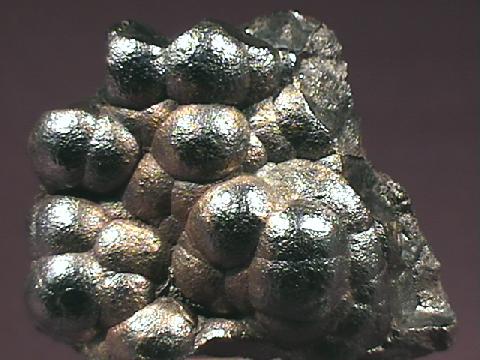
HEMATITE specimen hem-24
$ 25.00
$ 25.00
Dims: 2.4 x 2.2 x 1.0" (6.1 x 5.6 x 2.5 cm)
Wt: 5.5 oz. (156.8 g)
Chihuahua, Mexico
Part of a reniform Hematite crust makes up this small hand specimen. The intergrown nodules that make it up would measure 0.5" (1.3 cm) individually, and are in excellent condition. Their outer surfaces have been polished to take advantage of their dark gray color and their metallic luster. The color of the crust is basically gray, but portions of its outer surface have a golden-brown coloration that I usually associate with trying to polish items with a brass wire wheel. The inner surface of the crust has a dull, deep red color and a dull luster, and shows slight evidence of some tiny crystals. Its cross-section shows the almost compact, fibrous and radiating habit that this material has.

hem-24 ($ 25.00)
Chihuahua, Mexico
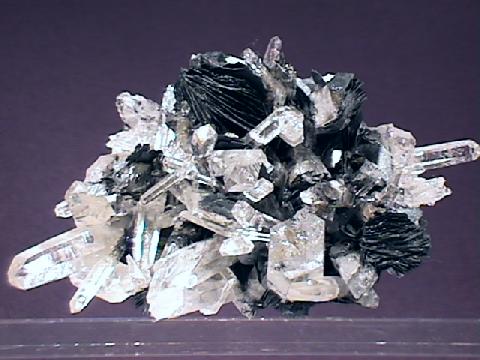
HEMATITE specimen hem-26
$ 75.00
$ 75.00
Dims: 3.7 x 2.3 x 2.2" (9.4 x 5.8 x 5.6 cm)
Wt: 4.79 oz. (135.9 g)
Hunan Province, China
Several clusters and many loose blades of Hematite rest among the quartz prisms that extend from this specimen. These Hematite clusters are generally in good condition, though a few show substantial numbers of broken blades. The blades range in diameter from 0.2" (5 mm) to 0.7" (1.8 cm) and show an uneven, round form. However, they are generally uniform in this respect. All are extremely thin- they do not appear to exceed 1 mm in thickness. They have the standard dark gray color and dull metallic luster of Hematite, and appear to have formed prior to the formation of the quartz crystals that accompany them. Most of the quartzes are broken, but those that are intact reach a maximum length of 1.5" (3.8 cm). They are very well-formed and are colorless, transpa
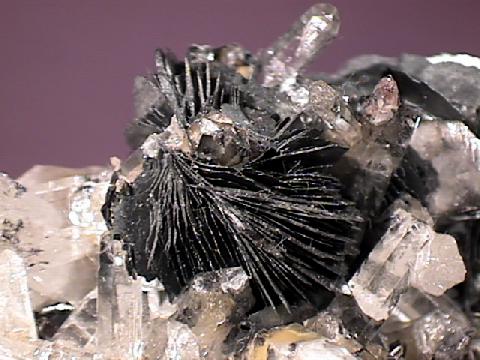

hem-26 ($ 75.00)
Hunan Province, China
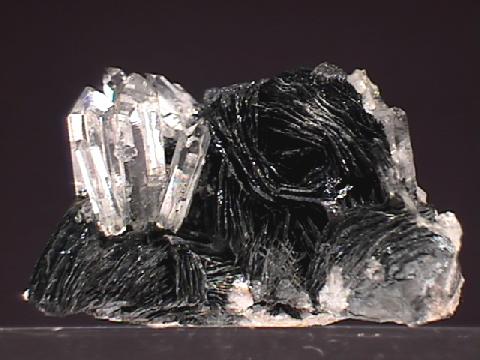
HEMATITE specimen hem-27
$ 115.00
$ 115.00
Dims: 2.2 x 1.6 x 1.4" (5.6 x 4.1 x 3.6 cm)
Wt: 3.55 oz. (100.7 g)
Hunan Province, China
This delicate specimen consists of several Hematite "roses", which are slightly radiating clusters of thin bladed crystals. These crystals do not exceed 2 mm in thickness, but achieve diameters of 0.8" (2.0 cm). They are in moderately good condition, as the three most exposed (and largest) clusters are noticeably damaged so that most of the crystals therein are likewise damaged. There are several smaller clusters, however, that are not damaged and in excellent condition. Though most of the Hematite blades are rounded and heavily intergrown, there are a few that show the hexagonal tabular form of this species. All have the dark gray color and dull, nearly metallic luster of Hematite. They are accompanied by at least 10 prismatic quartz crystals that are in excellent condition and have good hexagonal form. The quartzes are colorless, transparent, clear and have the standard vitreous luster. An equal number of quartz crystals are broken and incomplete. The base rock of the specimen appears to be made of quartzite, and is lightly interspersed with more Hematite blades.
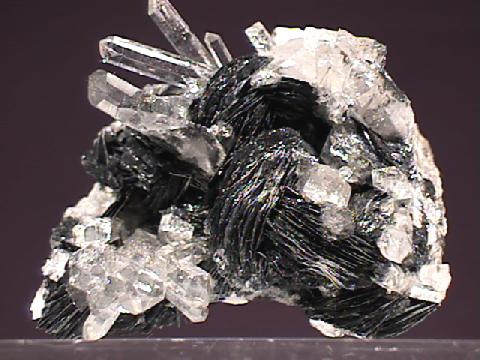

hem-27 ($115.00)
Hunan Province, China
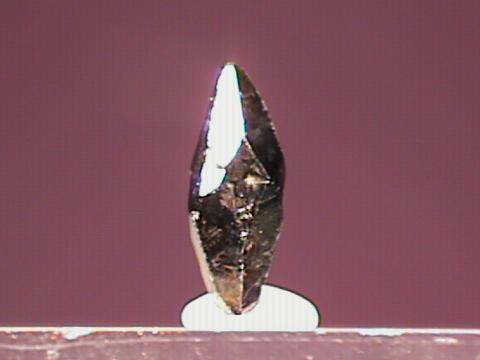
HEMATITE specimen hem-28
$ 80.00
$ 80.00
Dims: 0.3 x 0.1 x 0.1" (8 x 3 x 3 mm)
Wt: 0.2 g
Arzanah Island, near Abu-Dhabi, United Arab Emirates
This small specimen consists of a single, doubly-terminated Hematite scalenohedron. It shows very minor damage at one tip and has very good form, with well-defined edges and clean faces. It has a dark gray color and a dull metallic luster and shows an extremely faint but colorful iridescence. There is no host rock present.

hem-28 ($ 80.00)
Arzanah Island, near Abu-Dhabi, United Arab Emirates
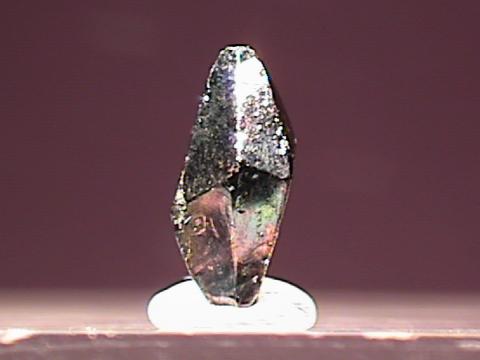
HEMATITE specimen hem-29
$ 80.00
$ 80.00
Dims: 0.3 x 0.1 x 0.1" (8 x 3 x 3 mm)
Wt: 0.2 g
Arzanah Island, near Abu-Dhabi, United Arab Emirates
A single, very small Hematite scalenohedron makes up this specimen. It is in excellent condition, showing no human-induced damage, and has good form- it is double-terminated and has moderately well-defined edges and clean faces. It has a dark gray coloration and a dull metallic luster that is slightly iridescent. It is not attached to any base or host rock.

hem-29 ($ 80.00)
Arzanah Island, near Abu-Dhabi, United Arab Emirates
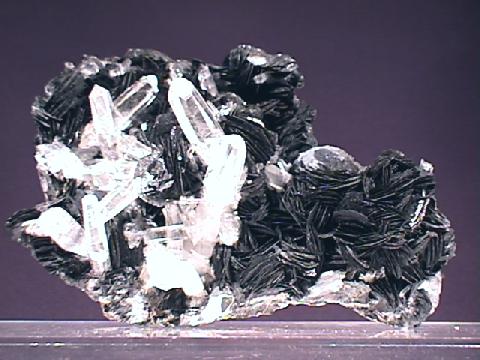
$ 225.00
Dims: 4.9 x 3.4 x 3.4" (12.4 x 8.6 x 8.6 cm)
Wt: 1 lb., 14.2 oz. (856 g)
Hunan Province, China
At least 20 intergrown Hematite "rosettes" rest on the granitic host rock of this large hand specimen. These "rosettes" are in generally good condition and measure up to 0.8" (2.0 cm) in diameter. Each rosette is made up of many intergrown rounded Hematite blades. Their hexagonal tabular form is moderately good, as none have a definite hexagonal shape, but their edges are very sharp, and their faces are reasonably smooth, possessing a matte-to-dull-metallic luster. The clusters generally appear black in color, but their faces are a dark gray. The Hematites are accompanied by several intergrown quartz crystals that reach lengths of 1.8" (4.6 cm), are in moderately good condition, and have excellent hexagonal prismatic form. The base rock appears to be made of an almost granitic material that is heavily interspersed with broken Hematite and quartz crystals.
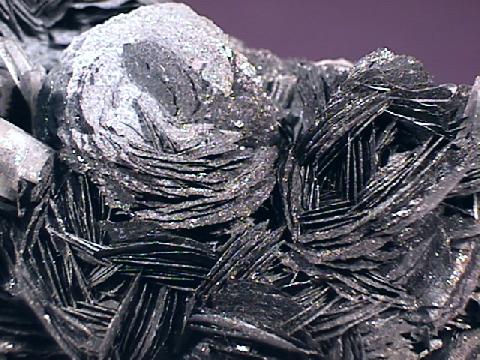

Hunan Province, China
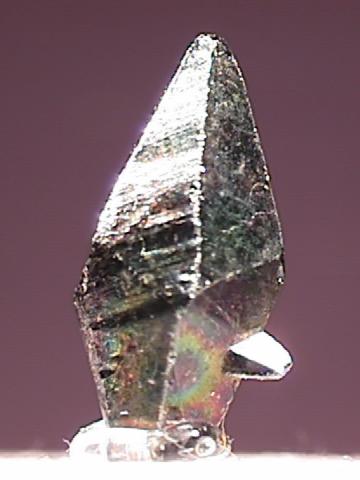
HEMATITE specimen hem-31
$ 115.00
$ 115.00
Dims: 0.5 x 0.2 x 0.2" (1.3 x 0.5 x 0.5 cm)
Wt: 1.0 g
Arzanah Island, near Abu-Dhabi, United Arab Emirates
This tiny specimen consists of two intergrown Hematite crystals. The smaller crystal has visible dimensions of 2 x 1 x 1 mm and is mostly intergrown with the larger crystal, whose dimensions make up most of the piece as a whole. They are in very good conditon, showing only a very tiny amount of damage on each termination, and have excellent trigonal scalenohedral form. The large crystal is doubly-terminated and has well-defined edges and striated but clean faces that possess a slightly iridescent, dull metallic luster. They have the standard dark silvery-gray color of Hematite and are, of course, opaque. There is no host rock present. As far as I know, this locality is the only known producer of scalenohedral Hematites.


hem-31 ($115.00)
Arzanah Island, near Abu-Dhabi, United Arab Emirates
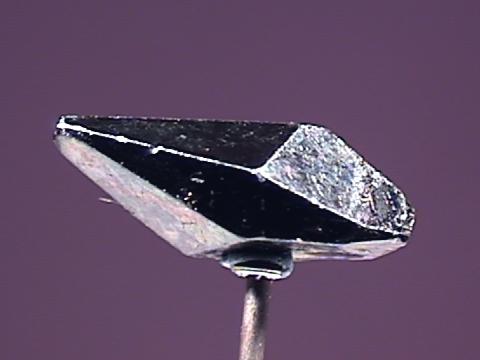
HEMATITE specimen hem-33
$ 80.00
$ 80.00
Dims: 0.4 x 0.2 x 0.2" (1.0 x 0.5 x 0.5 cm)
Wt: 0.7 g
Arzanah Island, near Abu Dhabi, United Arab Emirates
Though this Hematite scalenohedron may appear to be damaged upon first glance, it is actually in excellent condition. It has excellent form and is double terminated, though one termination is truncated by a small, nearly basal face. It has well-defined edges and generally clean faces, though one shows some form-related pitting. It has the standard dark gray color and dull metallic luster of its kind, and each face shows a very subtle, colorful iridescence. There is no host rock present, of course.

hem-33 ($ 80.00)
Arzanah Island, near Abu Dhabi, United Arab Emirates
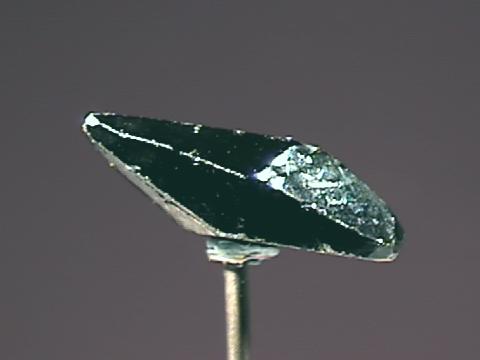
HEMATITE specimen hem-34
$ 40.00
$ 40.00
Dims: 0.3 x 0.1 x 0.1" (8 x 3 x 3 mm)
Wt: 0.3 g
Arzanah Island, near Abu Dhabi, United Arab Emirates
This tiny Hematite crystal shows excellent trigonal scalenohedral form and is doubly-terminated. What appears to be fresh damage are actually small pits that are formed due to growth irregularities- it is actually in excellent condition. The crystal has the classic dark gray color and dull metallic luster of Hematite.

hem-34 ($ 40.00)
Arzanah Island, near Abu Dhabi, United Arab Emirates
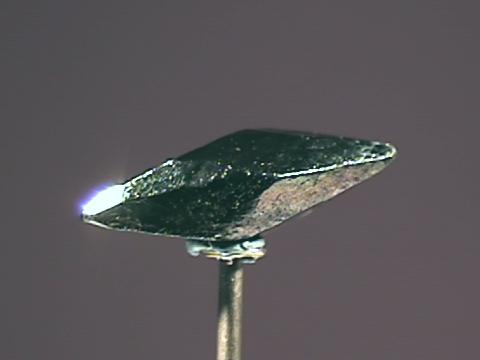
HEMATITE specimen hem-35
$ 40.00
$ 40.00
Dims: 0.3 x 0.1 x 0.1" (8 x 3 x 3 mm)
Wt: 0.3 g
Arzanah Island, near Abu Dhabi, United Arab Emirates
This specimen consists of a small but very well-formed Hematite scalenohedron that is in excellent condition. It shows no damage and has well-defined edges and clean faces. Its dark gray color and dull metallic luster are standard for its species, but it shows a noticeable and colorful iridescence on all surfaces. There is no host rock present.

hem-35 ($ 40.00)
Arzanah Island, near Abu Dhabi, United Arab Emirates
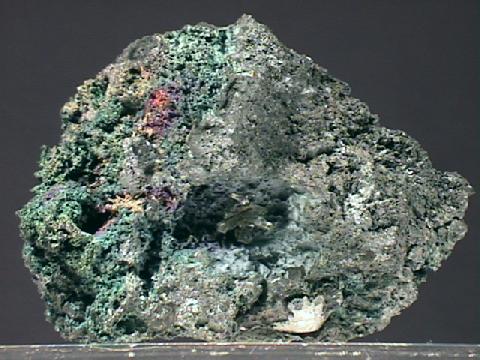
HEMATITE specimen hem-37
$ 35.00
$ 35.00
Dims: 2.4 x 2.1 x 1.3" (6.1 x 5.3 x 3.3 cm)
Wt: 4.50 oz. (127.7 g)
Cole Shaft, Bisbee, Arizona, U.S.A.
This small hand specimen consists of a thin, colorful crust of a variety of Hematite known as Turgite which coats a manganese "wad" base. This crust is completely massive and so thin that only its color shows that it is there. Blue and green hues are dominant, though there are noticeable areas of violet and red coloration, also. Resting atop the Turgite crust are 2 cerussite crystals. Both of these crystals have formed incomplete cyclic twins.
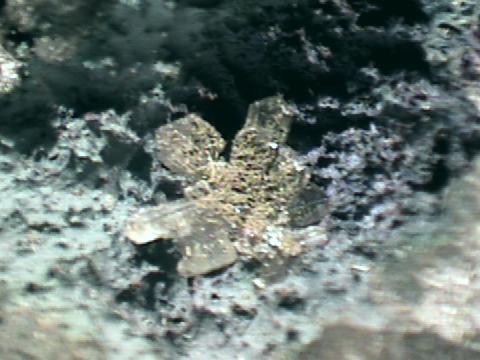

hem-37 ($ 35.00)
Cole Shaft, Bisbee, Arizona, U.S.A.
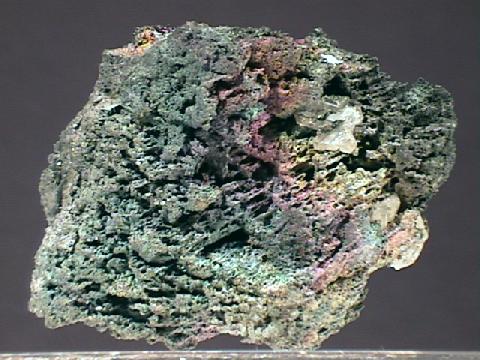
HEMATITE specimen hem-38
$ 35.00
$ 35.00
Dims: 2.0 x 1.7 x 1.3" (5.1 x 4.3 x 3.3 cm)
Wt: 2.54 oz. (71.6 g)
Cole Shaft, Bisbee, Arizona, U.S.A.
A very thin crust of Turgite, a hydrous variety of Hematite, coats the manganese oxide base of this small hand specimen. The Turgite shows no crystal form, but is easy to see due to its bright coloration against the black base. Its coloration ranges from red to yellow to green to blue, and many shades between them. Resting on the Turgite crust are several cerussite crystals, at least 2 of which are twinned. They are in good condition and have excellent orthorhombic prismatic form.
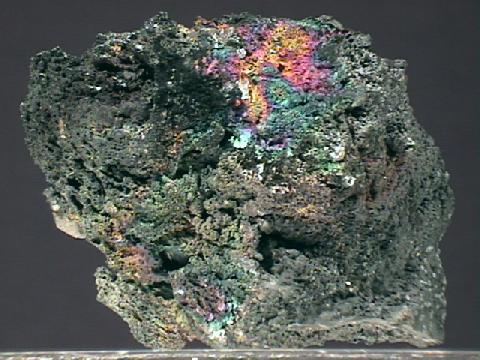

hem-38 ($ 35.00)
Cole Shaft, Bisbee, Arizona, U.S.A.
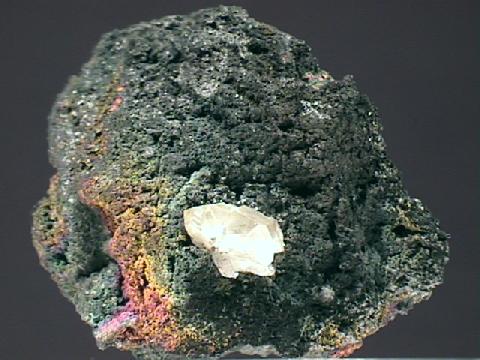
HEMATITE specimen hem-39
$ 35.00
$ 35.00
Dims: 1.5 x 1.4 x 1.1" (3.8 x 3.6 x 2.8 cm)
Wt: 1.52 oz. (43.3 g)
Cole Shaft, Bisbee, Arizona, U.S.A.
A thin, colorful Turgite crust coats the manganese oxide base of this specimen. This crust shows no crystal form and has colors of blue, green, red, yellow and orange. Along with the Turgite rests a single, incomplete Cerussite cyclic twin. It is in good condition and shows good orthorhombic form and the standard pale beige color.

hem-39 ($ 35.00)
Cole Shaft, Bisbee, Arizona, U.S.A.
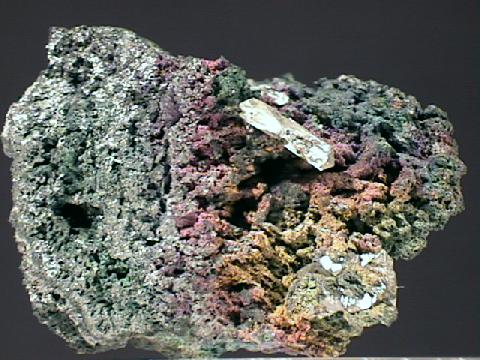
HEMATITE specimen hem-40
$ 35.00
$ 35.00
Dims: 1.6 x 1.1 x 1.1" (4.1 x 2.8 x 2.8 cm)
Wt: 1.42 oz. (40.4 g)
Cole Shaft, Bisbee, Arizona, U.S.A.
The manganese oxide base of this piece is partly covered with a thin crust of Turgite, a variety of Hematite. This crust shows no crystal form and is extremely thin, but is easy to see due to its varied coloration, which span the visible spectrum. Resting atop the crust are two incomplete cyclic twins of cerussite that are in good condition and show reasonably good crystal form.

hem-40 ($ 35.00)
Cole Shaft, Bisbee, Arizona, U.S.A.
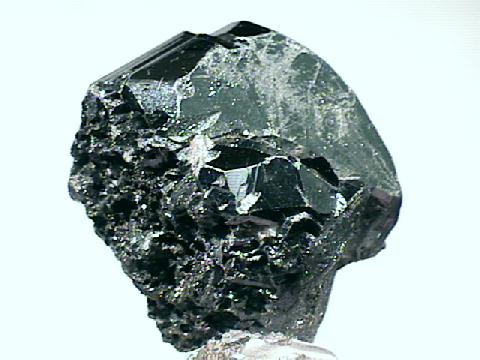
HEMATITE specimen hem-41
$ 105.00
$ 105.00
Dims: 1.5 x 1.5 x 1.5" (3.8 x 3.8 x 3.8 cm)
Wt: 3.38 oz. (95.8 g)
N'Chwaning Mine, Kuruman, South Africa
This specimen consists of at least 3 incomplete, partly-intergrown Hematite crystals. These crystals appear to be very heavily damaged, but only a small portion of this damage occurred after the piece was mined- most of the breakage surfaces show definite partial-healing. The largest crystal has dimensions of 1.5 x 1.2 x 1.2" (3.8 x 3.0 x 3.0 cm) and shows partial but very good hexagonal form- though normally bladed, these crystals are nearly thick enough to be prismatic. Where intact, they have well-defined edges and often striated but clean faces. The largest crystal appears to be an inter-penetration twin. All have the classic dark gray color and metallic luster of their species. There is no host rock present, and the piece is hot-glued onto a flat acrylic base.

hem-41 ($105.00)
N'Chwaning Mine, Kuruman, South Africa
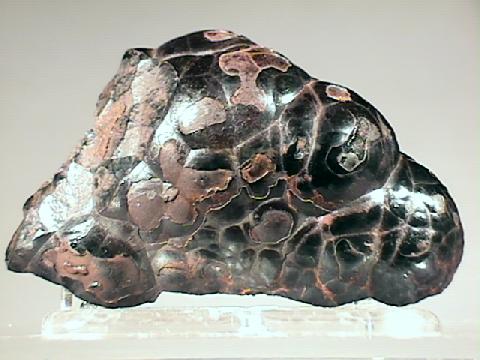
HEMATITE specimen hem-42
$ 40.00
$ 40.00
Dims: 2.4 x 1.1 x 1.1" (6.2 x 2.9 x 2.8 cm)
Wt: 3.86 oz. (109.5 g)
Minas Gerais, Brazil
This interesting Hematite specimen consists of a piece of "kidney ore", a variety of Hematite that takes on a reniform habit. Its outer surfaces are generally rounded, smooth and undulating, though the outermost layer of material has chipped away in a few places. It shows the standard dark gray color and metallic luster on its outer layer, and a duller luster and reddish color on the exposed inner layer and in places on its underside. The underside is interesting in that a layer is visible that denotes a compact, fibrous habit. There is no base or host material present.

hem-42 ($ 40.00)
Minas Gerais, Brazil
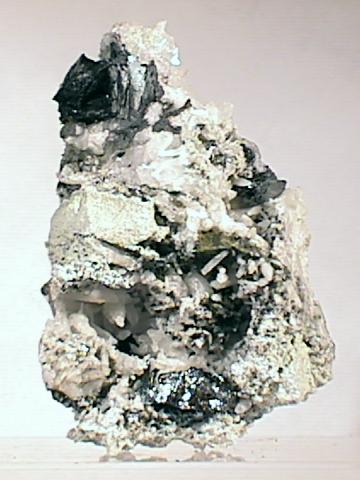
HEMATITE specimen hem-43
$ 45.00
$ 45.00
Dims: 3.7 x 2.3 x 2.1" (9.4 x 5.8 x 5.4 cm)
Wt: 8.5 oz. (242 g)
Creole Mine, Beaver County, Utah, U.S.A.
The Hematite in this hand specimen takes on the form of weird pseudo-crystals that are apparently formed through the intergrowth of countless thin, tabular crystals. Though many of the crystals are isolated and easy to see, damage is rather widespread, marring their shapes- even those that are well-protected and intact do not show any form of hexagonal outline. All have the dark, silvery-gray color and metallic luster of their species. The base in which they are embedded is made up of scores of heavily intergrown and water-worn quartz crystals that are milky-white in color and translucent at best.
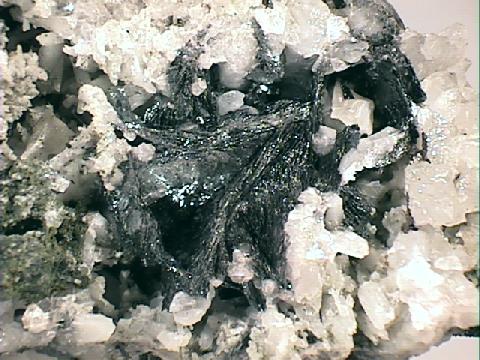

hem-43 ($ 45.00)
Creole Mine, Beaver County, Utah, U.S.A.
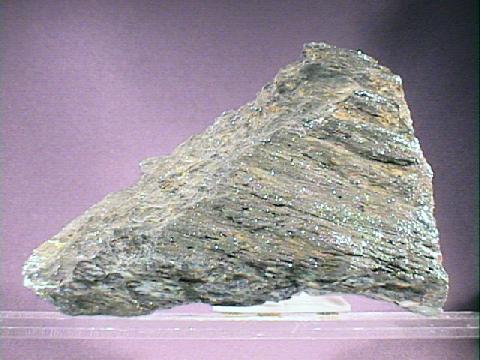
HEMATITE specimen hem-44
$ 72.00
$ 72.00
Dims: 5.9 x 3.9 x 2.2" (15.0 x 9.8 x 5.5 cm)
Wt: 3 lbs., 2.6 oz. (1.435 kg)
Keweenaw Peninsula, Michigan, U.S.A.
This large cabinet specimen consists of a chunk of "Rainbow Specular Hematite". The Hematite has a lamellar, semicrystalline habit- it is not quite massive, but does not actually form crystals. It has the moderately high density, dark gray color and submetallic luster of the specie, and shows a colorful iridescence when viewed from certain angles under bright light. The colors are predominantly red and green, but some areas show small spots of blue color.

hem-44 ($ 72.00)
Keweenaw Peninsula, Michigan, U.S.A.
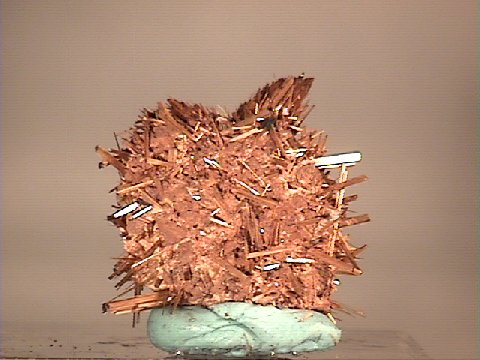
HEMATITE specimen hem-45
$ 30.00
$ 30.00
Dims: 1.0 x 0.7 x 0.6" (2.4 x 1.8 x 1.5 cm)
Wt: 14 g
Novo Horizonte, Bahia, Brazil
Several small patches of crystalline Hematite are embedded in the rusty, rutile-laden base of this thumbnail piece. They are generally in very good condition, showing little damage, if any. The largest Hematite crystal has dimensions of 0.3 x 0.3 x 0.1" (8 x 7 x 3 mm) and shows definite evidence of its hexagonal tabular form, though its outline is jagged and uneven. Three rutile aggregates extend from it at 60-degree angles. The Hematite has the classic dark gray color and slightly dull metallic luster. The piece is affixed inside a plastic specimen box with an adhesive putty.

hem-45 ($ 30.00)
Novo Horizonte, Bahia, Brazil
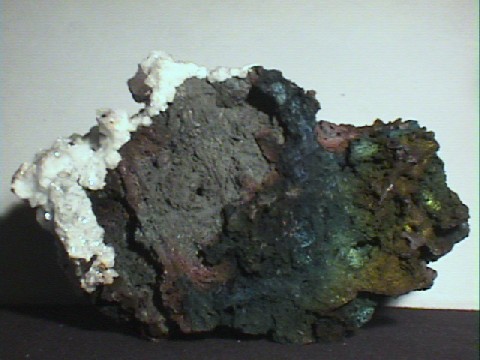
HEMATITE specimen hem-46
$ 39.00
$ 39.00
Dims: 6.9 x 4.1 x 1.9" (17.5 x 10.5 x 4.8 cm)
Wt: 1 lb., 11.4 oz. (890 g)
Sierra Mojada, Coahuila, Mexico
This large cabinet piece consists almost entirely of massive Hematite. Though showing some obviously crystalline habits, no discernable crystal form is evident. Most of the material has a dull luster and the standard black, brown or gray color, but part of the surface is coated with a thin layer of the Hematite variety Turgite, which shows a colorful iridescence. A crust of white calcite covers a small portion of the piece- it is heavily worn or etched.

hem-46 ($ 39.00)
Sierra Mojada, Coahuila, Mexico
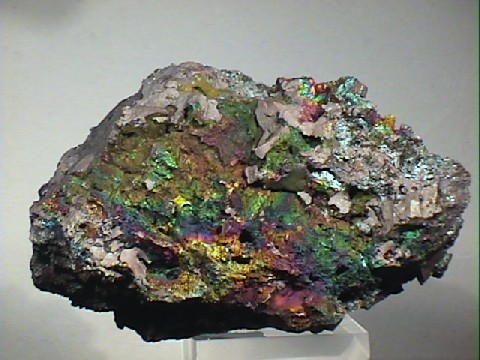
HEMATITE specimen hem-47
$ 31.00
$ 31.00
Dims: 5.0 x 3.1 x 2.3" (12.7 x 7.8 x 5.9 cm)
Wt: 1 lb., 8.8 oz. (703 g)
Sierra Mojada, Coahuila, Mexico
A chunk of mostly massive Hematite comprises this cabinet piece. Close examination will show many semicrystalline or crystalline faces on the surface of the specimen, though no actual crystals are present. The material shows mostly a black or brown coloration and a dull luster, but has a gray color and submetallic luster where semicrystalline formation has occurred. A thin layer of Turgite, however, has caused an intense iridescent coloration on much of its surface- these colors span the visible spectrum. There are no other minerals or materials present.

hem-47 ($ 31.00)
Sierra Mojada, Coahuila, Mexico
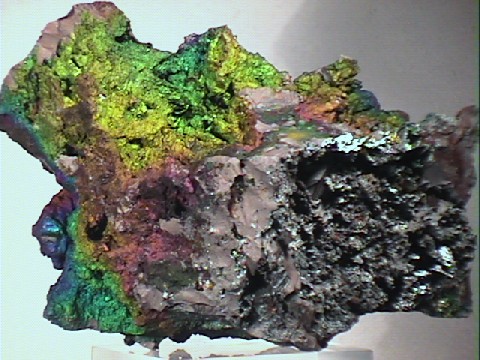
HEMATITE specimen hem-48
$ 30.00
$ 30.00
Dims: 4.8 x 3.0 x 2.3" (12.1 x 7.7 x 5.7 cm)
Wt: 1 lb., 5.1 oz. (596 g)
Sierra Mojada, Coahuila, Mexico
Among the massive Hematite that makes up most of the mass of this cabinet piece are some obvious crystalline formations. No complete crystals are present, however. This crystalline material has a gray color and a submetallic luster; portions of the massive material also share these traits, but most of it shows a duller gray, brown or black color and a dull, matte luster. However, a thin layer of Turgite that coats some of the massive material has given it an intense and colorful iridescence. There is no other material present on the piece.

hem-48 ($ 30.00)
Sierra Mojada, Coahuila, Mexico
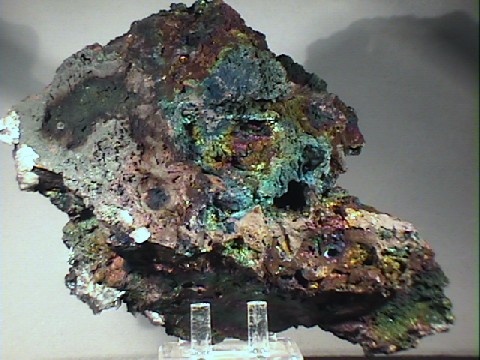
HEMATITE specimen hem-49
$ 98.00
$ 98.00
Dims: 8.5 x 6.0 x 3.1" (21.6 x 15.2 x 7.7 cm)
Wt: 5 lbs., 4 oz. ( 2.4 kg)
Sierra Mojada, Coahuila, Mexico
This large display specimen consists almost entirely of massive Hematite, but contains a few obviously crystalline formations, including a few thin blades in a hollow that I cannot identify- their form certainly is not conducive to Hematite. The material generally has a brown, black or gray color and a dull luster, though a few small spots are submetallic. However, the piece has a heavy Turgite coating over a large portion of its surface, giving it a beautiful iridescent color. Several small patches of weathered white calcite rest on the Hematite.
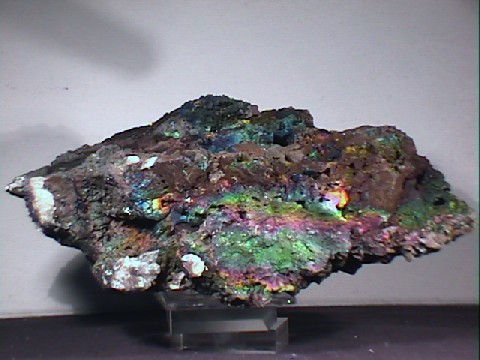

hem-49 ($ 98.00)
Sierra Mojada, Coahuila, Mexico
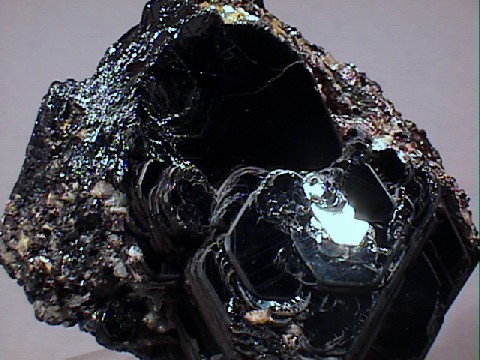
HEMATITE specimen hem-50
$ 84.00
$ 84.00
Dims:2.7x2.7x2.2" (6.9x6.9x5.6 cm)
Wt: 20.3oz. (575g)
Ouro Preto, Minas Gerais, Brazil
This is a cluster of hematite crystals intergrown in a form that is oft referred to as an "iron rose". This name comes from the resemblance of the crystals to the layering of rose petals in a bloom. These crystals are extremely lustrous, and are associated with tiny crystals of muscovite mica. On one side of the specimen the hematite crystals are stacked one atop another, this forms quita a thick "book" of crystals. This specimen shows only minor damage.
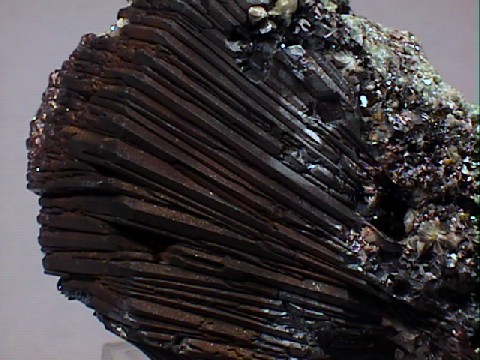

hem-50 ($ 84.00)
Ouro Preto, Minas Gerais, Brazil
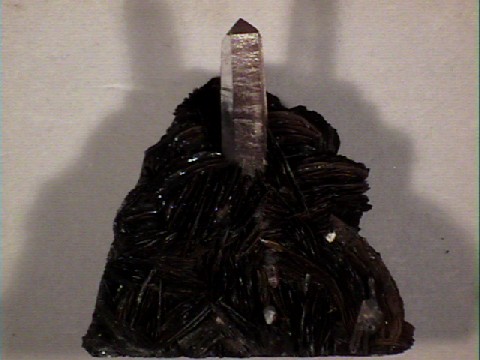
HEMATITE specimen hem-51
$ 110.00
$ 110.00
Dims: 2.51x2.44x1.83" (6.37x6.20x4.66cm)
Wt: 7.14oz (202.1g)
Heping, Guangdong, China
The pictures don't do this specimen justice - black on black just won't photograph well. A single nearly perfect quartz crystal rises from just above the center of a cluster of hematite roses, making a fairly striking presentation. The hematite is, of course, black and opaque, with the individual blades being generally well-formed. Many of the blades show minor damage, and there is a dusting of other minerals adding a gray or brown hue to the hematite from some viewpoints. There are actually quite a few smaller quartz crystals present, primarily on the back but also scattered on the front of the specimen. The smaller quartz crystals are technically citrine, as a thin outer layer has been stained yellow, predominantly towards the tips. That single large quartz crystal, on the other hand, is colorless except that exactly two of its faces have been roughened by inclusions of another mineral or two, almost with a sandpaper-like appearance.
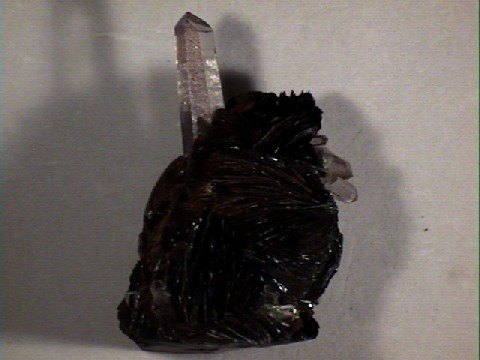

hem-51 ($110.00)
Heping, Guangdong, China
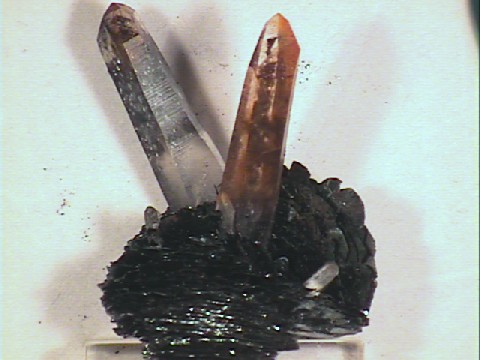
HEMATITE specimen hem-52
$ 140.00
$ 140.00
Dims: 1.4x1.8x1.5" (3.5x4.7x3.8cm)
Wt: 1.65 oz. (46.6g)
Le Chang Guang Dong Orivence, China
Two large quartz crystals highlight the black hematite base of this specimen. THe hematite crystals are in fragile books of platy crytals which are very specular. Some of the hematite crystals (on the bottom) show yellow, blue, and red irridescence. Both quartz crystals also have a coating of hematite crystals on a couple of faces, and one crystal appears red from a coating on some of its faces.
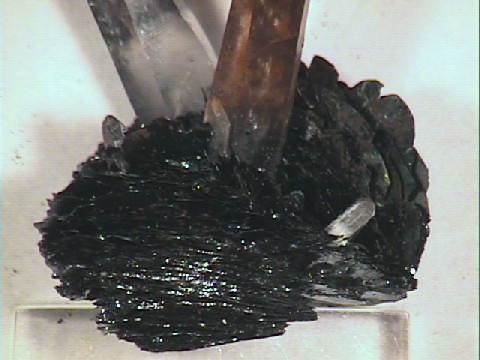

hem-52 ($140.00)
Le Chang Guang Dong Orivence, China
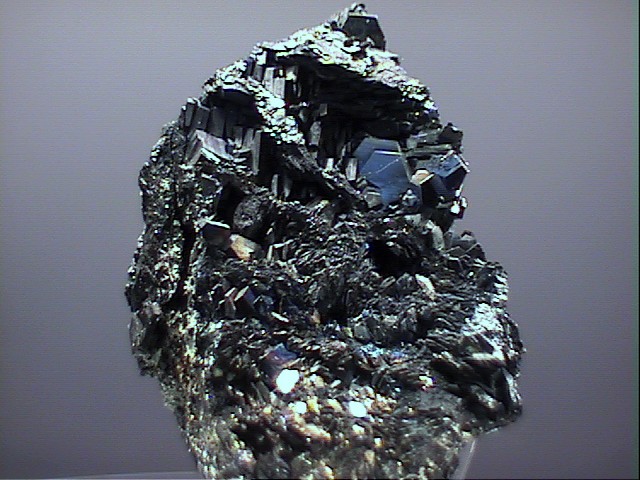
HEMATITE specimen hem-53
$ 45.00
$ 45.00
Dims: 2.52x1.78x0.95" (6.41x4.52x2.42cm)
Wt: 4.58oz (129.7g)
Bouse, Arizona, USA
This specimen is nearly all hematite, and these crystals are very good. They are all flat hexagonal plates of black, opaque hematite. Some of them have an irridescent coating dominated by shades of blue and purple. The crystals tend to have a metallic to vitreous luster on the faces, and a dull luster on the six sides of the hexagon. There are other minerals present, including quartz and a crust of a dull green mineral that looks like a massive form of serpentine.
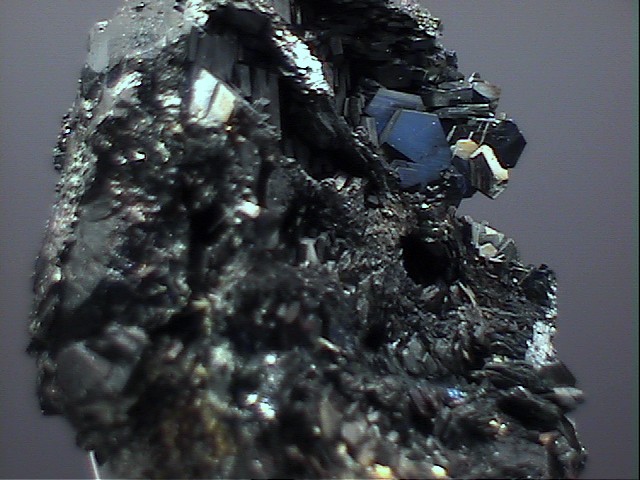

hem-53 ($ 45.00)
Bouse, Arizona, USA